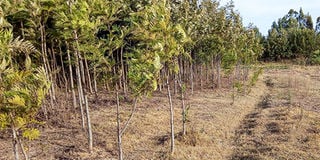Why grevillea robusta is most popular tree

Young Grevillea robusta trees. The tree is considered one of those which are a must-have on your farm. PHOTO | FILE | NATION MEDIA GROUP
What you need to know:
- A mature tree can stand up to 40 metres tall in its natural forest environment. But those planted on farms go up to 30 metres when mature.
- Seedling is the most common method of grevillea propagation. Its seeds do not need any pre-sowing preparation and will germinate between two and three weeks after sowing.
- Once established, grevillea is a hardy drought-resistant tree that requires little care. Of course it should be protected from grazing animals.
- Timber merchants value it higher than the whistling pine and if you are in beekeeping, grevillea is one of the must-have trees on your farm.
Grevillea robusta is a fast-growing evergreen tree that is among the most common in Kenya. Also known as silky oak, the tree originated in Australia and was introduced in the country by the British as a shade in coffee farms in the former white highlands.
It is thus a tree that lives well with crops because it also fixes nitrogen in the soil. Its branches have to be managed, though, so that they do not block the sunshine.
According to the World Agroforestry Centre, its local names are Mukima (Kamba), Mubariti (Kikuyu), Omokabiria (Kisii), Eshichuma (Luhya) and Kapkawet (Nandi).
It grows in regions with altitudes ranging from 0 in the Coast region to 3,000 metres above sea level. It does well on neutral to acidic loam or light sandy soils but it struggles in waterlogged soils or heavy clay.
One of the very few diseases it suffers from, root rot, strikes when it is planted in waterlogged soils. They are also vulnerable to fungal diseases, especially in humid regions.
A mature tree can stand up to 40 metres tall in its natural forest environment. But those planted on farms go up to 30 metres when mature.
Where can you grow this tree?
The Kenya Forestry Research Institute (Kefri) has divided the country into seven ecological zones. However, agroforestry only happens in five of these zones.
There is little tree planting in zones I and VII, because I is arid and no tree can survive while VII is in the natural public forests.
Grevillea grows in all the remaining five zones where annual rains range from less than 400mm to more than 1,400mm.
Propagation
Seedling is the most common method of grevillea propagation. Its seeds do not need any pre-sowing preparation and will germinate between two and three weeks after sowing.
When transplanting, the spacing depends on the end use of the tree. If you want to sell as poles or droppers, you can plant with a spacing of one metre. If you want the tree to expand for timber, the ideal spacing is at least two-and-a-half metres.
You can also plant with the one metre spacing but then give them more room for expansion at six years by selling poles. For timber, you have to wait for up to 30 years.
Once established, grevillea is a hardy drought-resistant tree that requires little care. Of course it should be protected from grazing animals.
The root system is vigorous hence it should not be planted near structures or drainage lines and sewerage systems as its roots have a tendency to pierce pipes and block them.
Like croton, grevillea is multi-branched hence it is very ideal for firewood. You do not have to cut down the tree, you just prune the branches.
Their other value is in charcoal, timber for furniture and construction, fodder, bee forage, mulch, soil conservation and windbreak.
Timber merchants value it higher than the whistling pine and if you are in beekeeping, grevillea is one of the must-have trees on your farm.
It has a wonderful display of golden yellow flowers that are a favourite for bees. The honey they produce will also be this colour.
Dairy farmers use their leaves as bedding material in livestock zero-grazing units. A mixture of manure and grevillea leaves make a very good addition to the soil.
Because its leaves are evergreen, it is an important dry season fodder in some parts of the country, especially in eastern Kenya. However, they are not as nutritious as those of croton whose protein content is as high as 50 per cent.
In some parts of Kenya, the One Acre Fund organisation is helping farmers grow the tree not just to fix depleted soils but to earn a living out of it.
Through this effort, farmers have planted more than five million grevillea trees since 2010.
Kiette Tucker and Allison Bream of One Acre Fund say the trees contribute to environmental sustainability by preventing soil erosion and removing carbon dioxide.
Each tree has a steep appreciation in value. In its first year, a seedling is worth less than Sh50. However, after five years of growth, the tree can fetch 50 times that amount.
There are some bottlenecks though. Some communities believe grevillea attracts lightning in homesteads. But this has not stopped it from being one of Kenya’s most popular trees.




